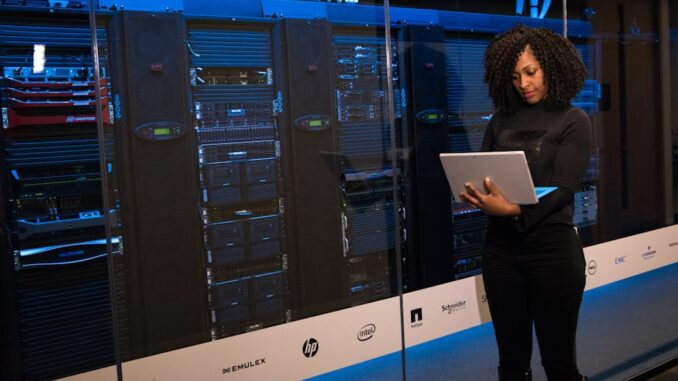
In today’s rapidly evolving digital landscape, organizations are increasingly seeking ways to balance operational efficiency with environmental responsibility. One effective strategy is the adoption of hybrid cloud data storage solutions, which not only optimize resource utilization but also bolster security measures.
The Rise of Hybrid Cloud Data Storage
Hybrid cloud data storage combines the scalability and flexibility of public cloud services with the control and security of private cloud infrastructures. This integration allows organizations to store sensitive data on private servers while leveraging public cloud resources for less critical operations. Such a configuration ensures compliance with data privacy regulations and enhances overall security posture.
Environmental Benefits of Hybrid Cloud Solutions
Implementing hybrid cloud strategies can significantly reduce a data center’s carbon footprint. For instance, a media and publishing company reported an 80% reduction in rack space and over 75% decrease in power consumption after adopting a hybrid multicloud infrastructure. These improvements not only contribute to sustainability goals but also lead to substantial cost savings. (nutanix.com)
Protect your data with the self-healing storage solution that technical experts trust.
Enhancing Security Through Automation
Automated security measures are crucial in hybrid cloud environments to protect sensitive data and maintain compliance. By automating tasks such as monitoring, risk assessment, and data classification, organizations can improve visibility and reduce the risk of human error. Implementing a zero-trust approach, which verifies every user’s access based on multiple factors, further strengthens security. (sisainfosec.com)
Case Studies Demonstrating Success
-
HSBC and Google Anthos: HSBC employs a hybrid cloud model using Google Cloud’s Anthos and their own private cloud. This approach enhances operational efficiency while ensuring rigorous data security, particularly for sensitive financial information. (thectoclub.com)
-
Netflix and AWS: Netflix leverages a hybrid cloud model, utilizing Amazon Web Services (AWS) for streaming services and content delivery, while maintaining a private cloud for billing and customer data systems. This strategy allows Netflix to scale its streaming capabilities on-demand and ensure a seamless viewing experience for its global audience. (netconglobal.com)
Best Practices for Implementing Hybrid Cloud Security
To effectively secure a hybrid cloud environment, organizations should consider the following best practices:
-
Prioritize Automation and Visibility: Automate monitoring and risk assessment to enhance visibility and reduce human error.
-
Focus on Data Discovery, Encryption, and Automation: Regularly identify and classify sensitive data, and ensure it is encrypted both at rest and in transit.
-
Standardize Data Security Policies and Controls: Implement consistent security controls across all cloud services to maintain a unified security posture.
-
Adopt a Zero-Trust Approach: Verify every user’s access based on multiple factors to minimize potential threats.
-
Enable Multi-Factor Authentication: Implement multi-factor authentication to provide an extra layer of protection against unauthorized access.
-
Create Secure Backups: Ensure recoverability in case of data loss by backing up both cloud-based and on-premises data, while keeping backup storage distinct from the original data source. (sisainfosec.com)
Conclusion
Adopting hybrid cloud data storage solutions offers a sustainable and secure approach for modern data centers. By integrating automated security measures and optimizing resource utilization, organizations can achieve both environmental and operational objectives. As demonstrated by various case studies, this strategy not only enhances security but also contributes to significant cost savings and improved efficiency.
References


The point about balancing efficiency and environmental responsibility is well-made. How do you see the role of serverless computing fitting into this hybrid cloud model, particularly in terms of further reducing energy consumption and optimizing resource allocation?
That’s a great question! Serverless computing definitely amplifies the benefits. By abstracting away server management, it allows for even more granular resource allocation, scaling up and down precisely when needed. This minimizes idle resources and wasted energy. It’s a powerful tool for maximizing efficiency in a hybrid cloud setup!
Editor: StorageTech.News
Thank you to our Sponsor Esdebe
The point about automated security measures is critical. How can organizations best ensure these automated systems are regularly updated to address emerging threats in a hybrid environment?
That’s a vital point! Staying ahead requires a proactive approach. Continuous monitoring of threat intelligence feeds, coupled with automated patching and vulnerability scanning, is essential. Regular security audits and penetration testing, tailored for the hybrid setup, can also help identify and address emerging risks. What strategies have you found effective in your organization?
Editor: StorageTech.News
Thank you to our Sponsor Esdebe
Given the reported 80% reduction in rack space, are there documented strategies to optimize physical infrastructure when transitioning to hybrid cloud storage?
That’s a great question! Beyond simply reducing rack space, documented strategies often involve a phased approach to migration. This allows for continuous monitoring and adjustment of physical infrastructure, ensuring optimal resource allocation throughout the transition. We can explore the best practices for phased implementation and continuous optimization.
Editor: StorageTech.News
Thank you to our Sponsor Esdebe
The discussion of automation for security is excellent. How do organizations address the challenge of maintaining consistent security policies across diverse cloud environments with varying native security features?